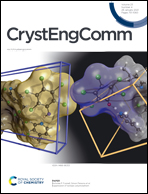Construction of hydrogen bonding and coordination networks based on ethynylpyridine-appended nucleobases†
Abstract
A series of eight derivatives bearing a 3- or 4-ethynylpyridine group and a nucleobase (adenine, cytosine, guanine or uracil) have been designed, synthesized and characterized. In particular, in the crystalline state, these derivatives form self-complementary hydrogen bonding motifs. Furthermore, the ability of these compounds to form complementary base pairs has been explored and two such hetero-molecular assemblies have been characterized in the solid state, using cytosine and guanine-based species. These pairs feature the expected hydrogen bonding recognition pattern, as observed in natural systems. Not only are these compounds prone to hydrogen bonding but they have been also employed as tectons for the formation of coordination networks upon association with a series of metal salts (Cd(NO3)2, Cu(OAc)2 and Cu(hfac)2 (hfac = hexafluoroacetylacetonate)). While, in some cases, both binding events can be observed with the pyridyl acting as a ligand and the nucleobase as an hydrogen bonding donor/acceptor, the tendency of the latter to also coordinate metal centers can lead to more complex assemblies. Thus, a similar 1D arrangement is observed resulting from coordination of the peripheral pyridyl group to the Cu(II) cations and self-complementary hydrogen bonding of either a uracil or cytosine moiety, upon assembly with Cu(hfac)2 or Cu(OAc)2, respectively. In these two cases, the nucleobases are not involved in coordination processes, unlike what is found in the other three networks obtained using the adenine-based tectons. In these networks, a recurrent self-complementary hydrogen bonding motif is found between the adenine moieties which also coordinate the metal cations via its N1 pyrimidinyl nitrogen atom. The dimensionality of these networks differs depending on the nature of the metal salt employed, the nuclearity of the metal node and the position of the pyridyl unit. These results demonstrate the soundness as well as the complexity associated with the combination of nucleobases with coordinating units for the construction of molecular networks.

- This article is part of the themed collection: Coordination Networks


 Please wait while we load your content...
Please wait while we load your content...